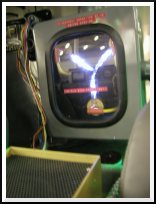
Posted on 04/15/2005 7:37:46 AM PDT by Excuse_My_Bellicosity

Scientists recently unveiled the tiniest electric motor ever built. You could stuff hundreds of them into the period at the end of this sentence.
One day a similar engine might power a tiny mechanical doctor that would travel through your body in the ultimate house call.
The motor works by shuffling atoms between two molten metal droplets in a carbon nanotube [watch it run].
One droplet is even smaller than the other. When a small electric current is applied to the droplets, atoms slowly eek off the larger droplet and join the smaller one. The small droplet grows – but never gets as big as the other droplet – and eventually bumps into the large droplet. As they touch, the large droplet rapidly sops up the atoms it had previously sloughed off. This quick shift in energy produces a power stroke.
The technique exploits the fact that surface tension -- the tendency of atoms or molecules to resist separating -- becomes more important at small scales. Surface tension is the same thing that allows some insects to walk on water.
The motor, a surface-tension-driven nanoelectromechanical relaxation oscillator, was built by a team of researchers led by Alex Zettl at the University of California, Berkeley.
Although the amount of energy produced is small -- 20 microwatts -- it is quite impressive in relation to the tiny scale of the motor. The whole setup is less than 200 nanometers on a side, or hundreds of times smaller than the width of a human hair. If it could be scaled up to the size of an automobile engine, it would be 100 million times more powerful than a Toyota Camry’s 225 horsepower V6 engine, the researchers say.
In 1988, Berkeley electrical engineering professor Richard Muller and colleagues made the first operating micromotor, which was 100 microns across, or about the thickness of a human hair. In 2003, Zettl's group created the first nanoscale motor. Last year they built a nanoconveyor, which moves tiny particles along like cars in a factory.
A paper discussing the latest invention was published in the March 21 issue of Applied Physics Letters.
Nanotechnology engineers try to mimic nature, building things atom-by-atom. Among other things, nanomotors could be used in optical circuits to redirect light, a process called optical switching. Futurists envision a day when nanomachines, powered by nanomotors, roam inside your body to find disease and repair damaged cells.
"This oscillator is ideal for locomotive applications, since it is so powerful for its size," Chris Regan, a Zettl group researcher, told LiveScience. "For instance, in a nanobot it could be used as the motor that drives crawling, walking, swimming, jumping, or flying."
More immediately, the new motor could be used within two years in existing Micro-Electro-Mechanical Systems (MEMS) technology, Regan said.
MEMS are tiny components made by etching away parts of a silicon wafer or adding tiny layers. As small as a grain of pollen, MEMS are larger than the nanoworld. They are employed in such things as microaccelerometers, the devices that activate automotive airbags. Optical MEMS are used in many home theater systems.
Regan said the shift to NEMS, the nano-equivalent of MEMS, "will take longer."

Credit: Zettl Research Group, Lawrence Berkeley National Laboratory and University of California at Berkeley

Microelectromechanical systems or MEMS are micro versions of electrical gears, motors, switches, etc. that are used to significantly reduce the size of many of today's and future devices from all kinds of industries. Common uses include defense/munitions applications, computer hard drives, optics, and many others. The image above shows the top view of gear reduction unit.
CREDIT: Courtesy Sandia National Laboratories, SUMMiTTM Technologies, www.mems.sandia.gov
Visit the source article for more links, pics, and animations.

Hey, is this from that phony paper submitted to the academic conference by MIT students?
Good catch, anyone want to verify?
BTW, sorry my link in the article (Watch it run) doesn't work. The link in the source article works.
One word: "Viagratron"
I guarantee it.
Since the perpetual motion machine is impossible, what is wasted in the process, and how long can the motor run?
In a short amount of time, everything living on the planet Earth will melt.

"a surface-tension-driven nanoelectromechanical relaxation oscillator"
That's the same principle that the Illudium Q-36 Explosive Space Modulator operates on.
Didn't the article say the application of electricity? (If I read it right.) It appears that it's power is not self-contained and must be applied to it.
Except, by that time, everyone on the planet will have access to the nanotechnology to protect against such insanity, developed to prolong and improve human life.
Except, of course, the madman designs a nanite meant to turn off such nanotechnological protections by unpluging the weeeeee little tiny power cord from the weeeeee little tuny electrical outlet.
"The Diamond Age" by Neal Stephenson is an interesting science fiction book about a future with nanotechnology. There are "protocols" which guide what can and cannot be done. And there are pretty effective means to make sure that the protocols are followed. But, of course, there's always a way to cheat ...
Good catch. Thanks.
Nanobump.

Nanu-technology?
This reminds me of the parody commercial played during Rush's show (if you listen to the stream from his website) about the 2008 Ford Excuse, Limited Edition..they made 12 to keep up with the demand.
Disclaimer: Opinions posted on Free Republic are those of the individual posters and do not necessarily represent the opinion of Free Republic or its management. All materials posted herein are protected by copyright law and the exemption for fair use of copyrighted works.